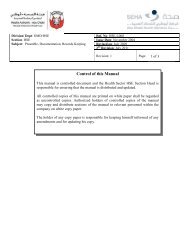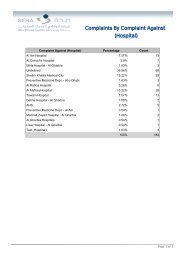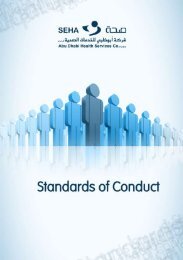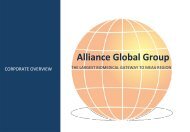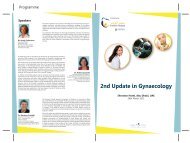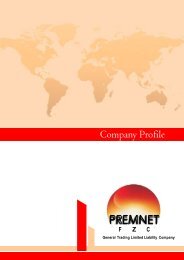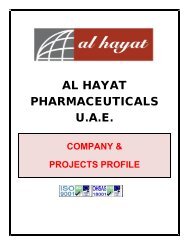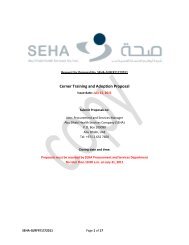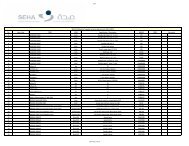Revenue Cycle Management - SEHA
Revenue Cycle Management - SEHA
Revenue Cycle Management - SEHA
- No tags were found...
Create successful ePaper yourself
Turn your PDF publications into a flip-book with our unique Google optimized e-Paper software.
<strong>Revenue</strong> <strong>Cycle</strong> <strong>Management</strong>Prepared by: Fianance Department
<strong>SEHA</strong> <strong>Revenue</strong> <strong>Cycle</strong> <strong>Management</strong>This submission has been designed based on STAR model which consists of Situation, Task, ActionTaken and Resultssignificantly improved across all <strong>SEHA</strong> facilities for auditing purposes and to meetthe targets set out for <strong>SEHA</strong> by the Abu Dhabi Government.In January 2010 a “Note of Understanding” was executed by the Health Authority ofAbu Dhabi (HAAD), the Department of Finance (DOF) and the Abu Dhabi HealthServices Company (<strong>SEHA</strong>) outlining the specific commitments of <strong>SEHA</strong> and HAADrequired to bring about <strong>SEHA</strong> business entity financial self-sufficiency and selfsustainabilitywith a target date of January 1st, 2013. The document illustrates thetransition from block budget funding to financial self-sufficiency - one of the keystrategic objectives of <strong>SEHA</strong>.Three key components are identified to achieve this:1. Appropriately funded public mandates2. Significant productivity gains / increases across all <strong>SEHA</strong> facilities3. Robust <strong>SEHA</strong> <strong>Revenue</strong> <strong>Cycle</strong> <strong>Management</strong> capability combined with marketbasedreimbursement ratesThe <strong>SEHA</strong> <strong>Revenue</strong> <strong>Cycle</strong> Transformation Project addresses the third componentby providing the <strong>SEHA</strong> business entities with the ability to improve collection andtracking of all hospital revenue. This project is key to reaching one of the strategicobjectives of <strong>SEHA</strong>, namely financial self-sufficiency.To assist <strong>SEHA</strong> achieve this, HAAD and DAMAN took away the exclusivity clauseof the <strong>SEHA</strong>/DAMAN Umbrella Contract of 2007 in May 2009, which was a yearearlier than originally mandated in the 5 year contract signed with DAMAN. Up untilthen, <strong>SEHA</strong> hospitals were only allowed to contract with DAMAN as an insurancecarrier. This gave <strong>SEHA</strong> the right to contract with other private insurancecompanies. <strong>SEHA</strong> quickly realised that the billing system was not set up to handlemultiple payers and the goal of contracting with other payers became of paramountimportance to increase revenue. The team laid out the design for a multipayerbilling system to manage these new payers and used this opportunity to design anAccounts receivable subsidiary.The need for improved revenue collection was identified by the <strong>SEHA</strong> CorporateSenior <strong>Management</strong> by consulting financial records and annual reports across all<strong>SEHA</strong> facilities.The need for changing to electronic claims was mandated by the Health Authority inorder to submit claims for patients holding THIQA insurance. At <strong>SEHA</strong> facilities,80% of insurance revenue is generated through THIQA claims; therefore it wasThese links/documents are designed only for the International Business Award Jury use as support documents to <strong>SEHA</strong>entries. It may contain confidential information and is intended solely for the person to whom it is addressed.Unauthorized forwarding, disclosing, copying or taking any action in reliance on the contents of this information isstrictly prohibited.
<strong>SEHA</strong> <strong>Revenue</strong> <strong>Cycle</strong> <strong>Management</strong>This submission has been designed based on STAR model which consists of Situation, Task, ActionTaken and Resultscritical for <strong>SEHA</strong> to action a plan to submit these claims electronically in order not tolose revenue.The need to obtain financial self-sufficiency by the <strong>SEHA</strong> facilities has alsocontributed to identifying the need to improve revenue collection and tracking.All the facilities were given specific Key Performance Indicators (KPI’s) by <strong>SEHA</strong>Corporate and these partners have to manage the hospitals efficiently by achievingthese KPI’s. New financial and revenue cycle KPI’s were developed and <strong>SEHA</strong>Corporate recognised that to achieve these high targets set, the facilities wouldneed to be given the tools and guidance, lead by the corporate office.The key parties involved in identifying this need were:a) <strong>SEHA</strong> Corporate Finance Department,b) <strong>SEHA</strong> Corporate Information Technology Department, Corporate <strong>SEHA</strong> ITBilling Projects managerc) Senior <strong>Management</strong> at all <strong>SEHA</strong> Business Entitiesd) <strong>Revenue</strong> <strong>Cycle</strong>As 2013 has been identified as the date that <strong>SEHA</strong> facilities are to achieve financialself-sufficiency, the need to improve and increase revenue collection and tracking isof paramount importance to achieve this goal. This target has been seen as veryambitious and therefore this project was given the highest priority.The Health Authority of Abu Dhabi has also made many changes that impactrevenue collection, such as mandating the code sets used; establishing the formatof electronic claims, and setting the tariffs for the Basic Abu Dhabi Plan product. Inorder to comply with these changes, <strong>SEHA</strong> facilities had to make immediatechanges to the billing system in order to process claims and generate revenue.Without this, <strong>SEHA</strong> would not have been able to generate any revenue frominsurance claims, so one might say that this project was more than a priority, it wasa necessity.Health care revenue cycle management consists of staff education, operationalprocess improvement, methodologies and techniques that medical institutions useto capture and report charges which represent the care, services, drugs andmedical supplies/equipment provided to a patient, to issue invoices and to collectpayments from the government, insurance companies and other organizations forthese services.The <strong>SEHA</strong> <strong>Revenue</strong> <strong>Cycle</strong> Transformation Project hoped to achieve the following:1. Facilitate the transition from manually-generated paper claims to electronicclaims for all <strong>SEHA</strong> business entities.These links/documents are designed only for the International Business Award Jury use as support documents to <strong>SEHA</strong>entries. It may contain confidential information and is intended solely for the person to whom it is addressed.Unauthorized forwarding, disclosing, copying or taking any action in reliance on the contents of this information isstrictly prohibited.
<strong>SEHA</strong> <strong>Revenue</strong> <strong>Cycle</strong> <strong>Management</strong>This submission has been designed based on STAR model which consists of Situation, Task, ActionTaken and Results2. Provide the <strong>SEHA</strong> business entities with the ability to improve collection andtracking of all hospital revenue.3. Improve revenue collection within all <strong>SEHA</strong> facilities by increasing the hospitalfee schedules to meet with market and international standards and assist thesefacilities to become financially self-sufficient.Task:At the time of the project going live, the billing system in use was the MicrosoftGreat Plains Billing System. This was implemented throughout the <strong>SEHA</strong> facilitiesin 2006 by the Health Authority of Abu Dhabi and then inherited by <strong>SEHA</strong> Corporateto manage and maintain. There were many complaints from the facilities about thesystem and concerns over whether or not it would be able to manage the electronicclaims process.The other billing system available to <strong>SEHA</strong> at the time was PROFIT, the billingmodule of the Cerner system. Cerner offers a platform of products for bothretrieving and disseminating patient-specific clinical and financial data across anentire health care system and is being implemented across all <strong>SEHA</strong> facilities tocreate the fully integrated electronic medical record. Although <strong>SEHA</strong> has purchasedthe patient billing platform (named PROFIT), it had not yet been implemented aspriority was initially given to the clinical and documentation modules.The only alternative to the Microsoft Great Plains Billing System considered wasPROFIT, as <strong>SEHA</strong> wants to move towards one integrated system, rather thandevelop integration engines to integrate alternative solutions.PROFIT (Cerner) was rejected at the onset of the Project to process electronicclaims and create an AR subsidiary for the following reasons:1) To comply with HAAD regulations, the entire methodology of billing claims hadto change and PROFIT would have had to been entirely rebuilt. Expert Cernerresources were not available to <strong>SEHA</strong> at the time for the PROFIT system as thefocus was on the implementation of the electronic medical record, rather thanthe billing piece. Microsoft Great Plains has the necessary resources availableto change the existing billing system.2) <strong>SEHA</strong> did not have experts at the corporate level who had extensive PROFITknowledge. On the contrary, there were plenty of resources available internallyat the <strong>SEHA</strong> Corporate level to initiate the changes needed to the Great Plainssystem.3) When PROFIT was initially assessed, there were a number of major designchanges that would take time to develop in order to mould the product to theUAE market. This would have impacted negatively on revenue collection as thedeadlines given would not be met in time while these design changes wereimplemented.These links/documents are designed only for the International Business Award Jury use as support documents to <strong>SEHA</strong>entries. It may contain confidential information and is intended solely for the person to whom it is addressed.Unauthorized forwarding, disclosing, copying or taking any action in reliance on the contents of this information isstrictly prohibited.
<strong>SEHA</strong> <strong>Revenue</strong> <strong>Cycle</strong> <strong>Management</strong>This submission has been designed based on STAR model which consists of Situation, Task, ActionTaken and ResultsAlthough PROFIT was not chosen initially due to time constraints, it is the <strong>SEHA</strong>Corporate vision that it will be used in future. The system is more robust and fullyintegrated and is currently being developed to handle all <strong>SEHA</strong> Corporate Billingfunctions.often consulted by both parties for assistance and guidance on how to implementchanges across the Abu Dhabi Healthcare sector.Mr. Tashtoush was recruited by Dr. Kamal at the same time as Mr. Matouk. As aqualified pharmacist with a Master’s degree focusing on quality, it was Mr.Tashtoush’ responsibility to ensure all <strong>SEHA</strong> procured pharmaceuticals wereclassified according to the Green Rain Drug coding system implemented by HAAD.Mr. Tashtoush developed the initial pricelist of 2000 items which he has grown to4000 items, thereby enabling <strong>SEHA</strong> to bill for pharmaceuticals that are procured.concepts lead to his promotion to Senior Financial Analyst. In this role he performsanalysis of how the facilities are capturing revenue. He was also involved in thenegotiation with new payers and this will ultimately lead to increased revenuecollection.1) An increase in line items available to facilities to bill2) An increase in number of claims generated and billed3) An improvement to the IT system allowing more charges to be captured, leadingto an increased average amount per claim and this more revenue generation4) A robust design to submit claims that were captured previously manually,electronically5) A robust design to set up appropriate financial classes and track all revenueacross all facilities6) Appropriate education and training and communication to all facilities about thechanges occurring<strong>Revenue</strong> cycle personnel from all facilities were invited to “brainstorm”improvements needed in the system. This was then presented to Senior <strong>SEHA</strong>Corporate management and the above factors were identified as critical successfactors. New Key Performance Indicators were set for the financial departmentsacross all <strong>SEHA</strong> facilities and it was clear they would not be able to do so untilabove criteria were met.The traditional phased project approach was applied, namely:Project initiation stageProject planning and design stageProject execution and construction stageThese links/documents are designed only for the International Business Award Jury use as support documents to <strong>SEHA</strong>entries. It may contain confidential information and is intended solely for the person to whom it is addressed.Unauthorized forwarding, disclosing, copying or taking any action in reliance on the contents of this information isstrictly prohibited.
<strong>SEHA</strong> <strong>Revenue</strong> <strong>Cycle</strong> <strong>Management</strong>This submission has been designed based on STAR model which consists of Situation, Task, ActionTaken and ResultsProject monitoringProject completionDue to the dynamic nature of the project with goals and targets changing constantlyas changes to the Abu Dhabi Health sector were introduced rapidly by HAAD,project planning was not optimal and often designs were reactive rather thanproactive.Individual parts of the project were put into timelines, such as the one below:The project cost was minimised due to the fact that <strong>SEHA</strong> used available resourcesfrom facilities and the corporate office to initiate and work on the project. The largestcost incurred was the implementation of the improvements to the IT system toenable it to handle multiple payers. These totalled around 580 000 AED.These links/documents are designed only for the International Business Award Jury use as support documents to <strong>SEHA</strong>entries. It may contain confidential information and is intended solely for the person to whom it is addressed.Unauthorized forwarding, disclosing, copying or taking any action in reliance on the contents of this information isstrictly prohibited.
<strong>SEHA</strong> <strong>Revenue</strong> <strong>Cycle</strong> <strong>Management</strong>This submission has been designed based on STAR model which consists of Situation, Task, ActionTaken and ResultsAction:The total time initially allocated to the project was 2 years, but due to newrequirements that arose while the project was running; this was extended to aperiod of 2 years, from July 2008 to December 2010. This was determined bylooking at the scope of the project and the resources available. The project plan for<strong>SEHA</strong> over the next five years was also taken into consideration as to achievecertain goals in that project, transformation had to take place in the billing systemand this had to be driven by the <strong>Revenue</strong> <strong>Cycle</strong> Team.Initially weekly meetings were held and all standing issues and progress discussed.These meetings were minuted and objectives and tasks identified the actionneeded, the group responsible and the time deadline. As the changes neededbecame less, this meeting was held once every two weeks instead of weekly.Every two months, all progress was reported at the <strong>SEHA</strong> CFO Forum meetings ina PowerPoint presentation, detailing all targets met and milestones achieved, aswell as outstanding issues. In this way, all stakeholders were kept informed of allprogress on the project.One of the barriers expected was that new business healthcare rules and policieswere being written by the HAAD for rapid implementation and therefore the projecthad to be very flexible to cope with these changes.Another barrier expected was resistance to change from front-end users at the<strong>SEHA</strong> facilities from existing policies and procedures. To combat this, key revenuecycle personnel were invited to the RCM meetings and the team went out to thefacilities to provide education, training and guidance.A major difficulty that was encountered and not planned for was when the newpricelist was implemented in the system; the system was not able to cope with theamount of entries and effectively crashed. Facilities were not able to send electronicclaims for a number of months while the system was rebuilt. The RCM and IT teamsdeveloped spreadsheets for the facilities to track activities for claims and once thesystem was functional, this was then loaded into the “backend” of the system asone upload. In this way the facilities did not have to manually recreate all claims inthe system one by one.The decision by DAMAN to end the exclusivity clause of the Umbrella contract inearly 2010 (instead of April 2011), enabled <strong>SEHA</strong> to bill other insurance companiesfor services.These links/documents are designed only for the International Business Award Jury use as support documents to <strong>SEHA</strong>entries. It may contain confidential information and is intended solely for the person to whom it is addressed.Unauthorized forwarding, disclosing, copying or taking any action in reliance on the contents of this information isstrictly prohibited.
<strong>SEHA</strong> <strong>Revenue</strong> <strong>Cycle</strong> <strong>Management</strong>This submission has been designed based on STAR model which consists of Situation, Task, ActionTaken and ResultsAbu Dhabi: The National Health Insurance Company (Daman) will be giving up itsexclusivity rights for direct billing within the Abu Dhabi Health Services Company's(<strong>SEHA</strong>'s) health care facilities in the UAE, effective February 1.January 27, 2010When the revenue cycle team looked at the IT system, they soon realised that ithad not been designed to deal with multiple insurance payers. The project plan wasquickly drawn up and changes were implemented in the system within 6 months.This was tied to the building of an accounts receivable subsidiary ledger, whichwould be able to track all revenue sources.As mentioned previously, weekly meetings were held and minuted. Updates werepresented in the form of emails; PowerPoint presentations to Senior <strong>Management</strong>at the CFO meetings; education sessions were held at facilities and Senior<strong>Management</strong> discussed the project progress at Executive council meetings.As this project was critical to the success of <strong>SEHA</strong> achieving financial selfsustainability,there was little resistance to implementation. The facilities welcomedthe changes and contributed to achieving the project goals.This project focused more on the transformation of <strong>Revenue</strong> <strong>Cycle</strong> at facilities. Inthe near future auditing of revenue capture will begin and the focus will be more oncorrective action. During the project, the focus was more on giving the facilities thetools to capture revenue and educating them how to use them. As the systemdevelops so will the need for more controls and auditing at the facilities.Results:The <strong>SEHA</strong> <strong>Revenue</strong> <strong>Cycle</strong> Transformation Project has lead to improved revenuecollection capability of 351.31% from 2008 to 2009. The year-to-date improvementfrom 2008 to 2010 is 641.66% with facilities continuing to improve.The following results clearly show the improvement from 2008 through to 2010:These links/documents are designed only for the International Business Award Jury use as support documents to <strong>SEHA</strong>entries. It may contain confidential information and is intended solely for the person to whom it is addressed.Unauthorized forwarding, disclosing, copying or taking any action in reliance on the contents of this information isstrictly prohibited.
<strong>SEHA</strong> <strong>Revenue</strong> <strong>Cycle</strong> <strong>Management</strong>This submission has been designed based on STAR model which consists of Situation, Task, ActionTaken and ResultsNo of E-Claims Submitted:1,513,9394,399,4683238670200820092010The AED value of these submitted claims also increased significantly from 2008 to2010 as more line items were added to the pricelist, prices were improved and morefunctionality was added to the system enabling automatic charge capture. Reducingmanual entry has reduced human error and allows for faster claim generation andsubmission. The following graph shows the revenue capture increase from 2008 to2010:AED Value Per Claim Submitted:3,000,000,0002,000,000,0001,000,000,000565,354,8521,804,030,3052,707,644,459AED Value:02008 2009 2010If you combine the two graphs, you will notice that the average amount claimed perclaim has also increased as follows:These links/documents are designed only for the International Business Award Jury use as support documents to <strong>SEHA</strong>entries. It may contain confidential information and is intended solely for the person to whom it is addressed.Unauthorized forwarding, disclosing, copying or taking any action in reliance on the contents of this information isstrictly prohibited.
<strong>SEHA</strong> <strong>Revenue</strong> <strong>Cycle</strong> <strong>Management</strong>This submission has been designed based on STAR model which consists of Situation, Task, ActionTaken and ResultsAvg. AED/Claim Submitted:700600557615500400373300Avg. AED/Claim:20010002008 2009 2010This was due to the following:a) The ability of the system to capture more chargesb) The improvement of revenue capture at the facilities as they get used to thesystems available and implement polices to improve charge capturec) The electronic claim system is far more efficient than the manual paper claimprocessing utilized in the past and allows for mass data entry and integrationwith clinical systemsd) The increase in the amount of items on the pricelist that the facilities can bill forThe following chart shows the extent of changes made by the <strong>Revenue</strong> <strong>Cycle</strong> Teamto the original public hospital pricelist:15000Changes made to the <strong>SEHA</strong> Price List(Total Line Items Added from Jan. 2009 toOct. 2010 = 21159)13607100005000019693800201055 513 195No. Of Items Added fromJanuary 2009 - October 2010These links/documents are designed only for the International Business Award Jury use as support documents to <strong>SEHA</strong>entries. It may contain confidential information and is intended solely for the person to whom it is addressed.Unauthorized forwarding, disclosing, copying or taking any action in reliance on the contents of this information isstrictly prohibited.
<strong>SEHA</strong> <strong>Revenue</strong> <strong>Cycle</strong> <strong>Management</strong>This submission has been designed based on STAR model which consists of Situation, Task, ActionTaken and ResultsThe ability to track revenue has been significant across all <strong>SEHA</strong> facilities. Prior tothe project, revenue was only placed into two broad categories, namely DAMANInsurance and Self-pay. To illustrate, self-pay included funded mandates,sponsored and charity patients and there was no way to track this in the system.Facilities were forced to track these statistics on excel spreadsheets and reportingwas often inaccurate. The project created over 150 Plan codes and mapped theseto financial classes. In this way the facilities can now track all revenue potential frompatients and automatic reports will be available for both internal and externalauditors.Training of facility staff on the new systems, the importance of charge capture andrevenue cycle processes took place at the facilities as the new pricelists wereintroduced and as new functionality was built in the system. Diagrams such as thefollowing were used to explain processes and workflows:These links/documents are designed only for the International Business Award Jury use as support documents to <strong>SEHA</strong>entries. It may contain confidential information and is intended solely for the person to whom it is addressed.Unauthorized forwarding, disclosing, copying or taking any action in reliance on the contents of this information isstrictly prohibited.
<strong>SEHA</strong> <strong>Revenue</strong> <strong>Cycle</strong> <strong>Management</strong>This submission has been designed based on STAR model which consists of Situation, Task, Action Taken and ResultsThese links/documents are designed only for the International Business Award Jury use as support documents to <strong>SEHA</strong> entries. It may contain confidential informationand is intended solely for the person to whom it is addressed. Unauthorized forwarding, disclosing, copying or taking any action in reliance on the contents of thisinformation is strictly prohibited.
<strong>SEHA</strong> <strong>Revenue</strong> <strong>Cycle</strong> <strong>Management</strong>This submission has been designed based on STAR model which consists of Situation, Task,Action Taken and ResultsTargets were met within the deadlines given, although some deadlines wereextended due to limited functionality of the system and resources not alwaysbeing available. New targets were also added during the course of the project toaccommodate new rules and policies implemented by the Health Authority of AbuDhabi.Although the creation of an Accounts Receivable subsidiary ledger was not in theinitial scope of the project, the need for redesign of the system to accommodatemultiple payers presented the perfect opportunity to develop this in the systemand Ms. Miller took full advantage of this to improve revenue tracking. <strong>SEHA</strong>facilities will long reap the benefits of this as it will provide them with the toolsnecessary to pull accurate automatic reports for Senior <strong>Management</strong> andauditors and enable tracking throughout the year as they attempt to reachrevenue targets that are set. An example of some of the plan codes added areshown below. These fall under the Charity Financial Class:CharityPlan descriptionEndowmentRed CrescentSheikh Khalifa FoundationZayed FoundationZAKAT FundDubai Charity AssociationMohammed Bin Rashed FoundationFriends of CancerPlan NameNENDOWMNTNRED-CRESNTNSHKHAL-FDNNZAYED-FDNNZAKATNDUBAICHARNMBRASHEDNCANCER-FRDThroughout the project, manuals were given to the <strong>Revenue</strong> <strong>Cycle</strong> Teams at thefacilities which provided guidance on how to use the system. PowerPointpresentations were created with summaries of progress made and shared withSenior and middle level management at facilities and at the <strong>SEHA</strong> CorporateOffice. There was no one person responsible for this task and all team membersprovided education to facilities at various levels.The completion of this project provides the <strong>SEHA</strong> facilities with the ability toincrease their revenue collections by:These links/documents are designed only for the International Business Award Jury use as support documents to<strong>SEHA</strong> entries. It may contain confidential information and is intended solely for the person to whom it isaddressed. Unauthorized forwarding, disclosing, copying or taking any action in reliance on the contents of thisinformation is strictly prohibited.
<strong>SEHA</strong> <strong>Revenue</strong> <strong>Cycle</strong> <strong>Management</strong>This submission has been designed based on STAR model which consists of Situation, Task,Action Taken and Results1) the introduction of a more robust IT system enabling facilities to capture andbill more charges2) the building of an accounts-receivable (AR) subsidiary ledger which improvesthe tracking of revenue by payer3) continued collaboration with the Health Authority to improve price schedulesand the number of items billable4) training of facility staff on the new systems, the importance of charge captureand revenue cycle processes5) the establishment of corporate revenue cycle policies and guidelines6) Standing bi-monthly meetings of key <strong>Revenue</strong> <strong>Cycle</strong> personnel from allfacilities to ensure communication of all strategic implementations anddecisions and identification of problems and obstacles with any revenue cycleissue (e.g. unexplained payer denial of payment, system malfunction, HealthAuthority directive interpretation, patient authorization rejections, etc.)7) regular discussions with the insurance carrier (DAMAN) to improveauthorization, claims adjudication, and payment processes and policiesThese seven improvements mean that facilities now have the tools to capturemore revenue and thereby achieve the goal of financial self-sustainability.The hard work now begins as <strong>SEHA</strong> facilities need to optimise revenue collectionand reduce denial rates.By providing them with the tools, the <strong>SEHA</strong> <strong>Revenue</strong> <strong>Cycle</strong> TransformationProject encourages <strong>Revenue</strong> <strong>Cycle</strong> teams at the <strong>SEHA</strong> facilities to grow andmature and this will lead to further refinements in the system.Auditing at the facilities should prove to be a lot easier and facilities will havemore time to focus on problem resolution, rather than spending time andresources trying to identify the problems.As <strong>Revenue</strong> <strong>Cycle</strong> is a fairly new concept in the Public Healthcare facilities,during this project many of the team members learnt concepts and processesthemselves for the first time. They have imparted this knowledge to the revenuecycle teams at facilities and it is evident that teaching others is often the best wayto teach oneself!These links/documents are designed only for the International Business Award Jury use as support documents to<strong>SEHA</strong> entries. It may contain confidential information and is intended solely for the person to whom it isaddressed. Unauthorized forwarding, disclosing, copying or taking any action in reliance on the contents of thisinformation is strictly prohibited.
<strong>SEHA</strong> <strong>Revenue</strong> <strong>Cycle</strong> <strong>Management</strong>This submission has been designed based on STAR model which consists of Situation, Task,Action Taken and ResultsThe <strong>Revenue</strong> <strong>Cycle</strong> Team at <strong>SEHA</strong> Corporate feel proud to have been involvedin this initiative as it contributes significantly towards the company goal ofachieving financial self sustainability in 2013.These links/documents are designed only for the International Business Award Jury use as support documents to<strong>SEHA</strong> entries. It may contain confidential information and is intended solely for the person to whom it isaddressed. Unauthorized forwarding, disclosing, copying or taking any action in reliance on the contents of thisinformation is strictly prohibited.



